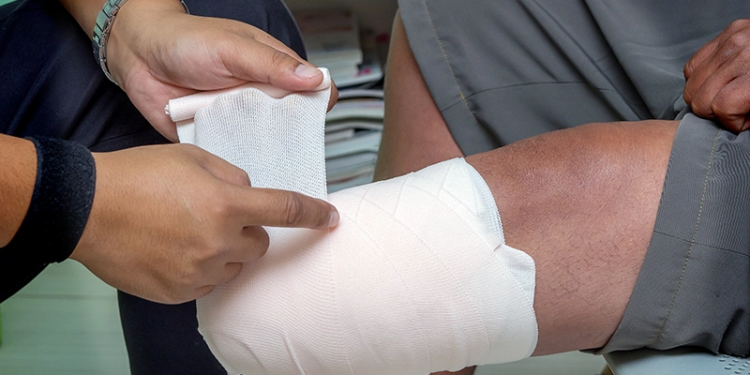Hello,
Thanks to all for your responses. Below are a list of responses I received.
I will recommend that the patient be fitted with a custom KO with a BK socket
serving as the distal component and a dynamic (ultraflex) knee joint. Some of
the responses alluded to the fact that getting reimbursed may be a problem,
but that’s another subject.
The patients residual limb is 4.75 inches and EMPI does not recommend their
device for residual limbs less than 5.5 inches.
It should also be noted that the patient has been fitted with a preparatory
prosthesis but limited progress is being made. A couple of responses made
suggestions concerning the proper alignment of the prosthesis. It will be
reevaluated with these suggestions in mind. The patient is ambulatory and
wearing the prosthesis approx. 4 hrs/ per day at present. The doctor and the
physical therapist are looking for a brace to aid in the reduction of the
contracture and maintain ROM gains at night.
Original post:
A physician has asked that we evaluate a patient, (BKA) in a local skilled
nursing facility, for an orthosis to improve 30-35 degree knee flexion
contracture. The patient is approx. 6 months post-op. Upon seeing the patient
I immediately think of a custom molded brace with essentially a BK socket and
dynamic (i.e., ultraflex) joint. The problem; there is quite a bit of
osteoarthritis and the patient complains of knee pain with mild stretching. I
am a bit skeptical that the orthosis will be tolerated and/or reduce the
contracture significantly, but in my opinion it is worth a shot.
If you have a preferred, cost effective strategy or opinion on the treatment
suggested in a case like this I would appreciate any feedback.
Thank you,
Eddie White, CP
Beacon P&O
Raleigh, NC
Responses:
Check out a prosthoses made by Empi specifically for this
problem.
**********
We used a posterior turn buckle attached to a bk socket used thick pelite or
plastizote liner to make like a hinged thigh lacer type prosthesis & pylon
with lightfoot so pt can ambulate. Used a poly a shell low density with a
pelite front with 2 11/2 inch velcro straps, time and patience it what it
takes
**********
I’ve made a device as you described through Ultra Flex. The tension on the
extension springs can be adjusted to a mild stretch, and increased as
tolerated. Good luck getting paid!
*********
EMPI has a BK contracture brace that I used once with good sucess.
**********
EMPI Corp makes a Bk Contracture Splint.
***********
If the patient is ambulatory, fitting with a prosthesis aligned with a short
heel lever arm will be much more effective in reducing the contracture than
any orthosis. If the patient is not ambulatory, why put the patient through
the pain and the health care system to the expense!! A 30-35 degree knee
flexion contracture does not necessarily prevent ambulation with a
prosthesis. Does the patient also have a hip flexion contracture?
**********
I use the Monodos (static, not dynamic joint), Becker Orthopedic. It’s
pretty slick: the joint only goes in one direction, unless released.
There’s probably more info on the Becker web site.
**********
EMPI have an Orthotic system called the Advance Dynamic ROM. There is a
version for the BK amputee. The principle is that it applies gentle low load
force to the joint acting upon connective tissue. The force is adjustable
and is a coiled spring so that there is no peak drop off. The brace is
adjustable and so is universal size. I t does however come in L&R, its not a
hassle to use it for both. Price is Xy, you can however reuse in a clinical
situation. The contact details are below:
**********
I have successfully treated numerous patients as you describe. In addition to
the usual regiment of PT stretching and exercise and clear instructions on
need
to maintain extended position when not wearing a prosthesis, I fit the patient
with either a temporary (USMC Gold unit or similar) or a modular prosthesis.
The
alignment is such that the patient cannot achieve heel contact during foot
flat
stage of gait or while standing. This exerts a continuous slight extension
moment to the knee. The more the patient walks the more active stretching is
achieved. As the patient is able to achieve heel contact I re-align (extend
the
socket). This process is continued, often having to transfer the socket back
to
a neutral jig when the mechanical end of range is reached, until no further
range
is noted. Slow process, which may be problematic from a funding angle.
Hope this helps.
*********
Empi makes an off-the-shelf product for trans-tib amputees. Tension is
adjustable. It does not work well on short limbs.
*********
Could you please post responses. Your situation has always be a problem.
********
The FLO-TECH-TOR portion of the APOPPS by FLO-TECH can reduce this type of
contracture fairly effectively with a slight modification. When ordering
state you want it for a flexion contracture and the modification will be made
to your specifications.
The best part about this type of reduction is the patient (if able) can
ambulate without changing sockets. The FLO-TECH-TOR remains on the patient
while the pylon and foot are removed after ambulation.




